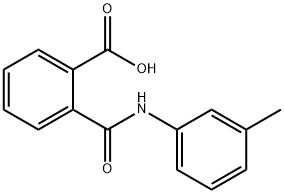N-M-TOLYLPHTHALAMIC ACID
- CAS NO.:85-72-3
- Empirical Formula: C15H13NO3
- Molecular Weight: 255.27
- MDL number: MFCD00020274
- EINECS: 201-626-9
- SAFETY DATA SHEET (SDS)
- Update Date: 2024-12-18 13:37:16

What is N-M-TOLYLPHTHALAMIC ACID?
Chemical properties
Crystalline solid. Soluble inalcohol and other polar solvents with decomposi-tion; slightly soluble in water.
The Uses of N-M-TOLYLPHTHALAMIC ACID
N-M-Tolylphthalamic Acid is used to prevent premature drop an anti shock treatment for pants. On ingestion is hydrolyzed to produce m-toluidine
The Uses of N-M-TOLYLPHTHALAMIC ACID
In agriculture as an antiscission agent for fruitsand vegetables.
Hazard
Toxic. Avoid ingestion.
Agricultural Uses
N-m-tolylphthalamic acid (N-m-t) is an auxin, a plantgrowth promoting substance. It improves the yield of tomatoes, cherries, eggplants and lima beans by increasing fructification.
Properties of N-M-TOLYLPHTHALAMIC ACID
| Melting point: | 150 °C |
| Boiling point: | 371.0±35.0 °C(Predicted) |
| Density | 1.295±0.06 g/cm3(Predicted) |
| storage temp. | -20°C Freezer |
| solubility | DMSO (Slightly), Methanol (Slightly) |
| form | Solid |
| pka | 3.46±0.36(Predicted) |
| color | White to Pale Red |
| CAS DataBase Reference | 85-72-3 |
| EPA Substance Registry System | 3'-Methylphthalanilic acid (85-72-3) |
Safety information for N-M-TOLYLPHTHALAMIC ACID
| Signal word | Danger |
| Pictogram(s) |
 Exclamation Mark Irritant GHS07  Health Hazard GHS08  Environment GHS09 |
| GHS Hazard Statements |
H319:Serious eye damage/eye irritation H372:Specific target organ toxicity, repeated exposure H400:Hazardous to the aquatic environment, acute hazard |
| Precautionary Statement Codes |
P264:Wash hands thoroughly after handling. P264:Wash skin thouroughly after handling. P273:Avoid release to the environment. P280:Wear protective gloves/protective clothing/eye protection/face protection. P391:Collect spillage. Hazardous to the aquatic environment P305+P351+P338:IF IN EYES: Rinse cautiously with water for several minutes. Remove contact lenses, if present and easy to do. Continuerinsing. P337+P313:IF eye irritation persists: Get medical advice/attention. P501:Dispose of contents/container to..… |
Computed Descriptors for N-M-TOLYLPHTHALAMIC ACID
New Products
4-Fluorophenylacetic acid 4-Methylphenylacetic acid N-Boc-D-alaninol N-BOC-D/L-ALANINOL Tert-butyl bis(2-chloroethyl)carbamate 3-Morpholino-1-(4-nitrophenyl)-5,6-dihydropyridin- 2(1H)-one Furan-2,5-Dicarboxylic Acid Tropic acid S-2-CHLORO PROPIONIC ACID ETHYL ISOCYANOACETATE 2-Bromo-1,3-Bis(Dimethylamino)Trimethinium Hexafluorophosphate (6-METHYL-[1,3]DITHIOLO[4,5-b]QUINOXALIN-2-ONE INDAZOLE-3-CARBOXYLIC ACID 4-IODO BENZOIC ACID (2-Hydroxyphenyl)acetonitrile 4-Bromopyrazole 5,6-Dimethoxyindanone 2-(Cyanocyclohexyl)acetic acid 4-methoxy-3,5-dinitropyridine 2-aminopropyl benzoate hydrochloride 1-(4-(aminomethyl)benzyl)urea hydrochloride diethyl 2-(2-((tertbutoxycarbonyl)amino) ethyl)malonate tert-butyl 4- (ureidomethyl)benzylcarbamate Ethyl-2-chloro((4-methoxyphenyl)hydrazono)acetateRelated products of tetrahydrofuran

![2-({3-[(SEC-BUTYLAMINO)CARBONYL]ANILINO}CARBONYL)-BENZOIC ACID](https://img.chemicalbook.in/CAS/GIF/940480-40-0.gif)

![2-({3-[(DIETHYLAMINO)CARBONYL]ANILINO}CARBONYL)-BENZOIC ACID](https://img.chemicalbook.in/CAS/GIF/940223-00-7.gif)




You may like
-
 3''-METHYLPHTHALANILIC ACID CAS 85-72-3View Details
3''-METHYLPHTHALANILIC ACID CAS 85-72-3View Details
85-72-3 -
 2033-24-1 98%View Details
2033-24-1 98%View Details
2033-24-1 -
 1975-50-4 98%View Details
1975-50-4 98%View Details
1975-50-4 -
 2-HYDROXY BENZYL ALCOHOL 98%View Details
2-HYDROXY BENZYL ALCOHOL 98%View Details
90-01-7 -
 2-Chloro-1,3-Bis(Dimethylamino)Trimethinium Hexafluorophosphate 221615-75-4 98%View Details
2-Chloro-1,3-Bis(Dimethylamino)Trimethinium Hexafluorophosphate 221615-75-4 98%View Details
221615-75-4 -
 61397-56-6 CIS BROMO BENZOATE 98%View Details
61397-56-6 CIS BROMO BENZOATE 98%View Details
61397-56-6 -
 14714-50-2 (2-Hydroxyphenyl)acetonitrile 98+View Details
14714-50-2 (2-Hydroxyphenyl)acetonitrile 98+View Details
14714-50-2 -
 118753-70-1 98+View Details
118753-70-1 98+View Details
118753-70-1
Statement: All products displayed on this website are only used for non medical purposes such as industrial applications or scientific research, and cannot be used for clinical diagnosis or treatment of humans or animals. They are not medicinal or edible.